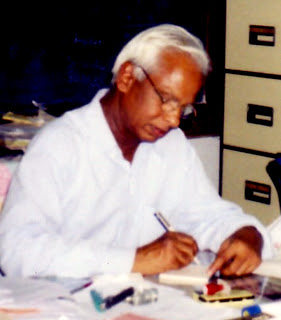What is Sarala’s take on this,
Mr. Sudeep Kanwal asks. Before answering this question, we should like to observe
that in the context of Sarala Mahabharata
this question translates itself into “Did Arjuna use celestial arrows after the
Kurukshetra War?” because in this narrative it is Krishna, not Arjuna, who fought
Aswasthama in the episode we have in mind. The latter’s brahmastra
killed Uttara’s child in her womb. The child born dead was restored to life by
Krishna. For more details, would you please see “The End of Aswasthama’s Story” in this
blog?
As Mr. Kanwal says, Arjuna fought
many times after the Great War in Vyasa Mahabharata. He had to, because King Yudhisthira had decided
to perform aswamedha jajna. In Sarala’s retelling Arjuna fought many
battles too. But not all were related to aswamedha
jajna. And sometimes he did use celestial arrows; in the terrible fight
against the demon Kadambasura, which had no connection with the jajna, he used the infallible divine
arrow pasupata, which he had got from
Bhagawan Shiva. This arrow was ineffective against the demon, but that’s a
story I will tell some other day.
In Sarala Mahabharata too Arjuna was in charge of the jajna horse for the aswamedha jajna. Ignoring details, the king of Jenabali, the young
Babrubahana, would not release the sacred horse. So Arjuna had to fight against
with him. In that encounter Arjuna used pasupata
astra to destroy his mighty army. He
then used the infallible narayanastra
(the arrow of Narayana) against the young king and Babrubahana used brahmastra to counter it. Arjuna’s arrow
killed Babrubahana and Babrubahana’s killed Arjuna. The sage Vyasa at
Hastinapura learnt about what had happened from the all-knowing Sahadeva and by
his yogic powers he travelled a long distance in no time and reached the
battlefield. He knew the mritasanjeevani
(a mantra that could bring life to the dead) mantra and revived them by using
this life-restoring mantra. Incidentally, this episode does not bring in
Krishna. More of this story, some other day.
When the avatara left his mortal
body, a deeply disappointed, agitated and confused Arjuna fought furiously with
the forest dweller, a deeply troubled and much devastated Jara, who had shot
that fatal arrow at Krishna’s foot unknowingly. He used the infallible divine
arrows babalastra and manavedi against Jara. Jara had
countered them with celestial weapons. The Creator god, Brahma, had to
intervene and stop that pointless fight. Let’s keep the rest of the story for
another post.
With Krishna’s leaving for his
celestial abode, Arjuna lost the Vaishnavic power. He was no more the same warrior.
But he was Indra’s son and Drona’s pupil. The power and knowledge that remained
with him was sufficient to tie up Yama’s messengers and then the god of death
himself at the time of Suhani’s wedding with Yudhisthira. The celestial arrows
that he used then were kala phasa and
manavedi . This story occurs in the
post “Suhani” in this blog.
Thus at least on these four
occasions Arjuna had used celestial weapons. But in the narrative of these
engagements excitement is missing. After the Kurukshetra War, no fight is
memorable. From one point of view, the divyastras
(divine weapons) become totally ineffective in a rather fundamental sense: they
fail to bring intensity and thrill to the narrative.

No comments:
Post a Comment